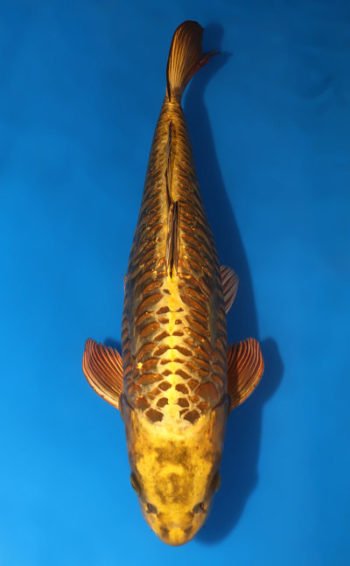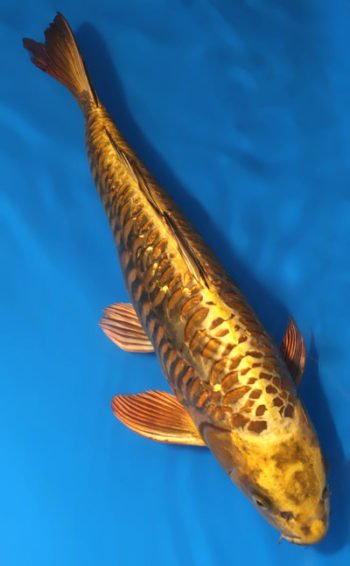Doitsu Mukashi Ogon Koi
See all of our high-quality koi fish for sale & butterfly koi fish for sale. We offer the very best selection of koi for sale in the industry. Put that alongside of our incredible 14-Day Live Arrival Guarantee, and the ability to choose your own delivery date and you have an unbeatable value.
14-DAY WORRY-FREE GUARANTEE: We offer an industry-leading 14-Day Worry-Free Guarantee to ensure that you can shop with peace of mind, knowing that you will always be covered.
Breeder(s): Arowana Paradise Farm
Sex: Female
Size: 19.29 inch
Variety: Doitsu, Doitsu Mukashi Ogon, Mukashi Ogon
$140.00 Original price was: $140.00.$120.00Current price is: $120.00.
Description
Doitsu Mukashi Ogon Koi For Sale
Doitsu Mukashi Ogon Koi, Some people love Doitsu Koi because they look like a cutout picture. Some people hate Doitsu because the scaleless skin looks odd. Either way, Koi in the Doitsu variety are beautiful and unique. They certainly add variety to your pond. Let’s talk more about the Doitsu variety.
Doitsu are Koi with few or no scales. It is an old, yet new group of varieties in Koi history. The first Doitsu Koi was developed more than 100 years ago, but new versions keep coming from this group because their scaleless characteristic can be crossed with almost any variety, like Ginrin (diamond scales).
Simply put Doitsu doubled the number of Koi varieties; for example, Kohaku and Doitsu Kohaku, Sanke and Doitsu Sanke, etc. Other varieties are Doitsu Showa, Kumonryu, Heisei Nishiki, and many more.
History of Doitsu: Koi are a kind of carp. Carp are food source in many countries. Scaleless carp were originally developed in Germany for ease of cooking. In 1904, the scaleless carp was imported to Denmark as a new food source. By the way, because scaleless carp were developed in and imported from Germany, they are called Doitsu. As you may imagine, Doitsu comes from the word “Deutsche”.
It may sound strange to pay attention to scales when we look at a scaleless Koi. But because Doitsu has less scales, how those scales are laid out affects its total beauty. One irregular scale at a wrong place could ruin the beauty of perfect Koi.
Koi in Doitsu variety group can have scales on the back along the dorsal fin and on the lateral lines of the body. If there are scales, they should line up all the way in consistent size of scales.
If you think about it, it is such a challenge to have the perfect layout of scales in Doitsu. No matter how perfect everything else is, in Doitsu, one wrong scale can ruin the entire beauty. We call those offending scales “Muda goke”. Therefore, nowadays, it seems that breeders try to breed Doitsu with as few scales as possible. It is easier to breed Koi with less scales than to breed them with perfect scale layout.
Koi Care Guide – Six things to know about your koi
- Experience Level: Intermediate
- Size: Koi grow up to 36 inches (91 cm) long
- Lifespan: They can live for more than 50 years and thrive in a wide range of water temperatures
- Temperament: They are generally peaceful but may pick on slower fish
- Origin: They’re a type of carp native to Japan
- Did You Know: Koi can learn to recognize and take food from their pet parents
How do I set up my koi’s aquarium?
- Koi grow quickly and get very large. Keep mature koi in an outdoor pond of at least 3 feet deep, with at least 50 gallons of water per fish.
- Young koi can be kept indoors in an aquarium of at least 29 gallons.
- Put the aquarium in a quiet area out of direct sunlight and drafts.
- Cover the aquarium with a hood to reduce evaporation and splashing and to keep fish from leaping out.
- To transfer new koi to the aquarium, float them in the water inside their bag for about 10 minutes so they can acclimate to the new water temperature.
- If you’re introducing koi to an existing school in an aquarium or pond, quarantine the new fish in a separate body of water for 2 to 4 weeks to be sure they are healthy.
- On moving day, use a net to transfer the koi so old water doesn’t mingle with new water.
- Whether they live indoors or outdoors, add no more than 3 new koi at a time.
Heat & light
Outdoor koi are hardy and will hibernate under ice in winter as long as their pond is deep enough to not freeze completely. (They won’t survive in solid ice.)
Your koi’s pond should be partially shaded.
Indoor koi prefer water between 65 and 75 degrees Fahrenheit.
Install a light inside an indoor aquarium to illuminate it for 8 to 12 hours a day.
Water temperature
Koi are pretty temperature-resistant— they can even hibernate under ice in winter. Just be sure your pond is at least three feet deep— otherwise, it could freeze solid, and koi aren’t that tough. When they live indoors, koi prefer cool water—between 65 and 75 degrees F (18 to 24 C).
How do I keep my koi healthy?
If your outdoor koi don’t seem to be eating in the winter, don’t worry; it’s normal for them to stop eating at temperatures below 40 F. Be sure to contact a veterinarian if you notice any of these symptoms:
- Unusual swimming pattern
- Thinness or decreased appetite
- Abdominal swelling
- Inflamed or discolored skin or fins
- Fins clamped to sides of body
- Scraping body on rocks (flashing)
types of koi fish, koi fish tattoo, koi fish price, koi fish pond, koi fish meaning, koi fish for sale, koi fish drawing, koi fish care, koi fish for sale online, butterfly koi for sale, koi fish for sale near me, big koi for sale, buy koi fish cheap, koi fry for sale usa, types of koi fish, koi fish for sale, High Quality Koi, Search Live Koi, doitsu koi price, doitsu sanke koi, doitsu koi varieties, black doitsu koi, doitsu koi for sale, yellow doitsu koi, doitsu kohaku, white doitsu koi





Reviews
There are no reviews yet.